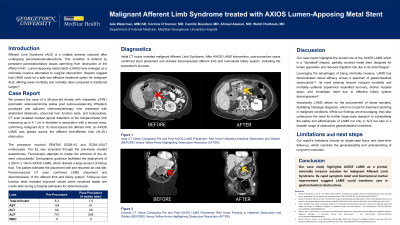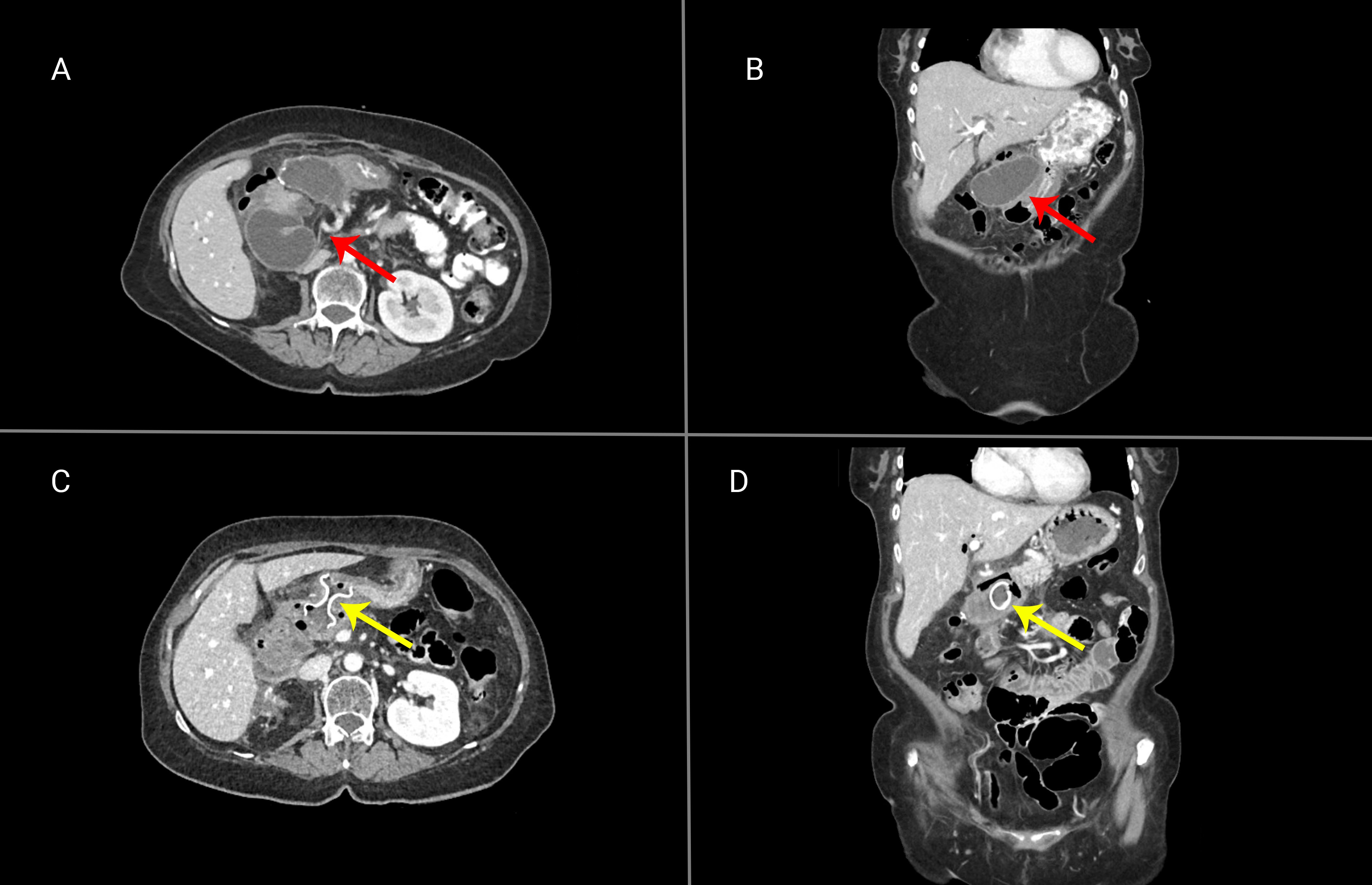Sunday Poster Session
Category: Interventional Endoscopy
P0898 - Malignant Afferent Limb Syndrome Treated With AXIOS Lumen-Apposing Metal Stent
Sunday, October 22, 2023
3:30 PM - 7:00 PM PT
Location: Exhibit Hall

Has Audio

Ade Waterman, MBChB
MedStar Georgetown University Hospital
Washington, DC
Presenting Author(s)
Ade Waterman, MBChB, Corinne O'Connor, MD, Camille Boustani, MD, Ahmed Alsaiari, MD, Walid Chalhoub, MD
MedStar Georgetown University Hospital, Washington, DC
Introduction: Afferent limb syndrome (ALS) is a rare complication of pancreaticoduodenectomy characterized by recurrent biliary complications due to obstruction of the afferent limb. Lumen-apposing metal stents (LAMS) have emerged as a minimally invasive alternative to surgical intervention. Reports suggest that LAMS could be a safe and effective treatment option for malignant ALS, offering lower morbidity and mortality rates compared to traditional surgery.
Case Description/Methods: We present the case of a 58-year-old female with metastatic pT4N1 pancreatic adenocarcinoma status post pylorus-preserving Whipple's procedure and adjuvant chemoradiotherapy who presented with stomach distension, abnormal liver function tests, and leukocytosis. Notable lab results included total bilirubin (8.3), direct bilirubin (6.40), AST (154), ALT (69), ALP (741), WBC (10.8). CT scan revealed marked jejunal distention of the biliopancreatic limb measuring up to 4.1 cm in diameter in association with a serosal mass, confirming malignant ALS. To decompress the afferent limb, an AXIOS LAMS was placed across the afferent limb-efferent limb (AL-EL) obstruction.
The procedure involved PENTAX EG29-i10 and EG38-J10UT endoscopes. The EL was accessed through the previously created anastomosis. Fluoroscopic attempts to locate the entrance of the AL were unsuccessful. Sonographic guidance facilitated the deployment of a 20mm x 10mm AXIOS LAMS, which drained a large amount of bilious fluid. The patient tolerated the placement well and resumed an oral diet. Post-procedural CT scan confirmed LAMS placement and decompression of the afferent limb and biliary system. Follow-up liver function tests revealed improved values: total bilirubin (1.9), AST (51), ALT (28), ALP (505), WBC (9.0), which remained stable one month later during a hospital admission for abdominal pain.
Discussion: Our case report highlights the successful use of AXIOS lumen-apposing metal stent in a patient with recurrent metastatic pancreatic cancer and malignant afferent limb syndrome. LAMS offers a minimally invasive alternative with proven effectiveness in various gastrointestinal obstructions. Its advantages include reduced morbidity and mortality rates, shorter hospital stays, quicker recovery times, biliary system decompression and the ability to obtain tissue samples for histologic diagnosis. Further research is warranted, but existing literature supports the potential of LAMS as a safe and effective tool in managing MALS and other obstructive indications.

Disclosures:
Ade Waterman, MBChB, Corinne O'Connor, MD, Camille Boustani, MD, Ahmed Alsaiari, MD, Walid Chalhoub, MD. P0898 - Malignant Afferent Limb Syndrome Treated With AXIOS Lumen-Apposing Metal Stent, ACG 2023 Annual Scientific Meeting Abstracts. Vancouver, BC, Canada: American College of Gastroenterology.
MedStar Georgetown University Hospital, Washington, DC
Introduction: Afferent limb syndrome (ALS) is a rare complication of pancreaticoduodenectomy characterized by recurrent biliary complications due to obstruction of the afferent limb. Lumen-apposing metal stents (LAMS) have emerged as a minimally invasive alternative to surgical intervention. Reports suggest that LAMS could be a safe and effective treatment option for malignant ALS, offering lower morbidity and mortality rates compared to traditional surgery.
Case Description/Methods: We present the case of a 58-year-old female with metastatic pT4N1 pancreatic adenocarcinoma status post pylorus-preserving Whipple's procedure and adjuvant chemoradiotherapy who presented with stomach distension, abnormal liver function tests, and leukocytosis. Notable lab results included total bilirubin (8.3), direct bilirubin (6.40), AST (154), ALT (69), ALP (741), WBC (10.8). CT scan revealed marked jejunal distention of the biliopancreatic limb measuring up to 4.1 cm in diameter in association with a serosal mass, confirming malignant ALS. To decompress the afferent limb, an AXIOS LAMS was placed across the afferent limb-efferent limb (AL-EL) obstruction.
The procedure involved PENTAX EG29-i10 and EG38-J10UT endoscopes. The EL was accessed through the previously created anastomosis. Fluoroscopic attempts to locate the entrance of the AL were unsuccessful. Sonographic guidance facilitated the deployment of a 20mm x 10mm AXIOS LAMS, which drained a large amount of bilious fluid. The patient tolerated the placement well and resumed an oral diet. Post-procedural CT scan confirmed LAMS placement and decompression of the afferent limb and biliary system. Follow-up liver function tests revealed improved values: total bilirubin (1.9), AST (51), ALT (28), ALP (505), WBC (9.0), which remained stable one month later during a hospital admission for abdominal pain.
Discussion: Our case report highlights the successful use of AXIOS lumen-apposing metal stent in a patient with recurrent metastatic pancreatic cancer and malignant afferent limb syndrome. LAMS offers a minimally invasive alternative with proven effectiveness in various gastrointestinal obstructions. Its advantages include reduced morbidity and mortality rates, shorter hospital stays, quicker recovery times, biliary system decompression and the ability to obtain tissue samples for histologic diagnosis. Further research is warranted, but existing literature supports the potential of LAMS as a safe and effective tool in managing MALS and other obstructive indications.

Figure: CT scans illustrating afferent limb distention before (images A and B) and distention improvement after AXIOS LAMS placement (images C and D). Afferent limb distention is marked by red arrows and AXIOS LAMS placement is marked by yellow arrows.
Disclosures:
Ade Waterman indicated no relevant financial relationships.
Corinne O'Connor indicated no relevant financial relationships.
Camille Boustani indicated no relevant financial relationships.
Ahmed Alsaiari indicated no relevant financial relationships.
Walid Chalhoub indicated no relevant financial relationships.
Ade Waterman, MBChB, Corinne O'Connor, MD, Camille Boustani, MD, Ahmed Alsaiari, MD, Walid Chalhoub, MD. P0898 - Malignant Afferent Limb Syndrome Treated With AXIOS Lumen-Apposing Metal Stent, ACG 2023 Annual Scientific Meeting Abstracts. Vancouver, BC, Canada: American College of Gastroenterology.
